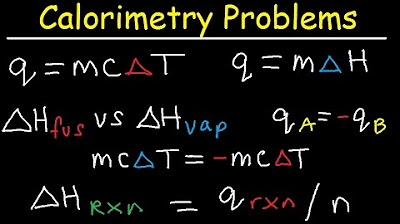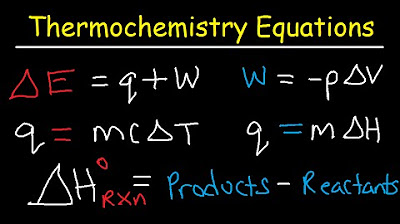Calculating Enthalpy and Entropy Using the NIST WebBook
TLDRThis video script demonstrates how to use the NIST WebBook for calculating thermodynamic properties such as enthalpy and entropy. It explains the process of obtaining gas phase thermochemical data for methane, using heat capacity equations and parameters provided for different temperature ranges, simplifying calculations with pre-calculated values for standard conditions.
Takeaways
- 📚 The NIST WebBook is a valuable resource for thermodynamics data, including enthalpy and entropy calculations.
- 🔍 To find specific data, you can search by chemical name, such as methane, to access its thermochemical data.
- 📈 The WebBook provides gas phase thermochemical data including heats of formation, combustion, and entropy.
- 🌡️ Heat capacity equations are temperature-dependent and are given for different temperature ranges with corresponding parameters.
- 🔢 The heat capacity parameters (A, B, C, D, E) and additional parameters (F and H) are essential for calculating enthalpy and entropy.
- ⚖️ Standard state is indicated by '0' and usually refers to one bar pressure.
- 📉 Enthalpy calculations are always differences, starting from the enthalpy at 298 K.
- 🔄 The WebBook accounts for the integration limits by incorporating them into the parameters F and H, simplifying the calculation process.
- ♨️ Temperature in equations is in Kelvin divided by a thousand, which is important for accurate calculations.
- 🔗 The integration for enthalpy requires multiplying by a thousand to convert from joules to kilojoules per mole.
- ⚛️ Entropy calculations are in joules per mole Kelvin, with a parameter G that accounts for the limits of integration.
- 📉 For temperatures above 1300 Kelvin, two sets of parameters are used, first integrating from 298 to 1300 K, then from 1300 K to the temperature of interest.
Q & A
What is the NIST WebBook and how is it valuable?
-The NIST WebBook is an online resource that provides a wealth of data for thermodynamics, including thermochemical data for various substances. It is valuable for scientists and researchers as it offers comprehensive information on properties such as enthalpy, entropy, and heat capacity as a function of temperature.
How does one search for a specific compound like methane on the NIST WebBook?
-To search for a specific compound like methane on the NIST WebBook, one would use the search function by name and enter 'methane' as the search term. The WebBook will then display a range of data related to methane, including its gas phase thermochemical data.
What is the significance of the heat capacity equation in the context of the NIST WebBook?
-The heat capacity equation is significant as it allows users to calculate the heat capacity of a substance at different temperatures. The equation is presented in terms of temperature divided by a thousand, and it is integral to determining enthalpy and entropy.
Why is it important to consider the standard state when calculating enthalpy?
-The standard state, indicated by '0' in the WebBook, is important because it provides a reference point for calculations. Enthalpy calculations are always differences from this standard state, typically at one bar pressure, ensuring consistency and comparability of data.
How are the parameters A, B, C, D, and E used in the calculation of enthalpy?
-Parameters A, B, C, D, and E are coefficients in the heat capacity equation provided by the NIST WebBook. They are used in the integration process to calculate the enthalpy of a substance at a given temperature relative to the standard state enthalpy at 298 K.
What do the parameters F and H represent in the context of enthalpy calculations?
-Parameters F and H are additional parameters provided by the NIST WebBook that account for the integration limits and simplify the calculation process. They represent the integrated heat capacity from the standard temperature (298 K) to the temperature of interest, already adjusted for the Kelvin to joule conversion.
Why is the temperature in the equations divided by a thousand?
-The temperature is divided by a thousand to adjust for the units of heat capacity, which is given in joules per mole. This adjustment ensures that when integrating with respect to temperature, the resulting enthalpy is in the correct units of kilojoules per mole.
How does the NIST WebBook simplify the calculation of entropy?
-The NIST WebBook provides a parameter G for entropy calculations, which accounts for the integration limits and simplifies the process. This allows users to calculate entropy directly from the given heat capacity parameters without additional conversions.
What is the difference between the calculation of enthalpy and entropy in terms of units?
-Enthalpy is calculated in kilojoules per mole to account for the integration with respect to Kelvin temperature, while entropy is calculated in joules per mole Kelvin, reflecting the temperature dependence of the property.
How does one calculate enthalpy at a temperature above 1300 Kelvin using the NIST WebBook data?
-For temperatures above 1300 Kelvin, one must first integrate from 298 to 1300 K using the first set of parameters, then from 1300 K to the temperature of interest using the second set of parameters. The WebBook provides F and H values for each temperature range to simplify this process.
Outlines
🔍 Exploring the NIST WebBook for Thermodynamic Data
This paragraph introduces the NIST WebBook as a valuable resource for thermodynamic data, specifically focusing on how to calculate enthalpy and entropy as functions of temperature. The speaker demonstrates how to access the WebBook, search for methane, and navigate to the gas phase thermochemical data. Key points include understanding the heat capacity equation, recognizing the parameters provided for different temperature ranges, and the significance of the standard state at one bar. The speaker also explains the process of calculating enthalpy differences by integrating the heat capacity equation and highlights the ease of use provided by the WebBook, which incorporates the necessary parameters for such calculations.
📚 Utilizing the NIST WebBook for Enthalpy and Entropy Calculations
In this paragraph, the speaker continues to delve into the use of the NIST WebBook, emphasizing the ease of calculating enthalpy and entropy with the provided equations and parameters. The explanation covers how the WebBook calculates specific terms and integrates them, simplifying the process for users. The speaker clarifies that for temperatures between 298 and 1300 Kelvin, the first set of parameters is used, while for temperatures above 1300 Kelvin, a two-step integration process is required, using parameters from both temperature ranges. The WebBook's convenience is highlighted by the pre-calculated values for F and H, which account for the integration limits and make the calculation of enthalpy and entropy straightforward. The speaker also notes the difference in units for enthalpy (kilojoules per mole) and entropy (joules per mole Kelvin), and how these are handled in the WebBook's calculations.
Mindmap
Keywords
💡NIST WebBook
💡enthalpy
💡entropy
💡heat capacity
💡temperature range
💡standard state
💡parameters A, B, C, D, E
💡integration
💡kilojoules per mole
💡joules per mole Kelvin
Highlights
Introduction to the NIST WebBook as a valuable resource for thermodynamics data.
Demonstration of how to calculate enthalpy and entropy as a function of temperature using the WebBook.
Explanation of searching for methane in the NIST WebBook and finding gas phase thermochemical data.
Discussion on heats of formation and combustion, and their values from multiple sources.
Emphasis on the importance of heat capacity equations and their parameters for temperature ranges.
Clarification that the zero in the data indicates the standard state at one bar.
Explanation of calculating the difference in enthalpy between a given temperature and 298 K.
Description of the WebBook's provision of equations for enthalpy with integrated constants A, B, C, D, E.
Highlight of the WebBook's inclusion of parameters F and H to simplify calculations without substituting limits.
Note on the temperature in equations being in Kelvin divided by a thousand.
Clarification that heat capacity and enthalpy calculations involve joules per mole, but enthalpy is in kilojoules per mole.
Explanation of how to calculate enthalpy at different temperatures by substituting into the appropriate equations.
Description of the WebBook's calculation of enthalpy terms, simplifying the process for users.
Illustration of how to integrate from 298 to 1300 K and then from 1300 K to the temperature of interest for enthalpy calculations.
Explanation of the WebBook's provision of F2 and H2 values for temperature ranges above 1300 K.
Clarification that the final result for enthalpy is in kilojoules per mole, while entropy is in joules per mole Kelvin.
Transcripts
Browse More Related Video

Thermochemistry Equations and Formulas With Practice Problems

Calorimetry Problems, Thermochemistry Practice, Specific Heat Capacity, Enthalpy Fusion, Chemistry

How to use Steam Table - Easiest Way

Gibbs free energy example | Thermodynamics | Chemistry | Khan Academy

Introduction to Steam Tables

Thermochemistry Equations & Formulas - Lecture Review & Practice Problems
5.0 / 5 (0 votes)
Thanks for rating: